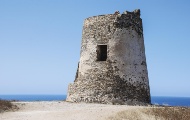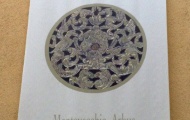To be seen
Using the form below, you can filter the list of contents. For text search you can use the character * (eg. Attiv * -> active, activity).
List

Amsicora shaft
Amsicora shaft, located in a charming valley, is a part of Telle stope (Montevecchio mine) and it is an extraordinary example of mining archaeology refurbishment.

Brassey lavery
The lavery of Naracauli is also called Brassey Lavery by the English Lord Thomas Alnutt Brassey, the mine’s owner. It started its activity in 1900 for the processing of blend.

Bruncu Espis giants' tomn
In Funtanazza, in an area called Bruncu Espis, where in the past there was a Roman village, there is a Giants’ tomb: built in Nuragic Age it was discovered in 1920 during the construction of a house.

Capo Pecora
Capo Pecora is a cape recognized by SIC (Site of Community Importance) located in the southern part of Costa Verde. The beach is characterized by a light and coarse grain sand with cliff falling sheer to the sea.

CEAS Ingurtosu
The Centre,which works in the territory of Arbus, has got various branches: in the ex staff canteen of Ingurtosu and in the stope of the shaft Pozzo Gal, in the ex Office of Geology of Montevecchio.

Entomological exhibition
The exhibition shows the links between men and insects putting in evidence the role that these little animals have in human activities.

Ethnographic museum
Antonio Corda’s Ethnographic museum collect and hands down the cultural properties of the rural world.

Flumentorgiu tower
Located at a few meters from Torre dei Corsari beach (from which it takes its name), it was built by Spanish at the end of XVI to control and defend the territory from Saracen invasions.

Funtanazza's beach
Funtanazza is a ravishing place immersed in the green pinewood that surrounds it. The beach is golden and the water is shallow ideal for children’s plays.

GAL shaft
The Gal shaft stope takes its name from Paul Gal, the President of Pennaroya Administrative Council, a French multinational that had got Pertusola Mines in 1920s.

Gutturu de Flumini's beach
Gutturu de Flumini is a little village in the south of Funtanazza, also known as Marina di Arbus.

Ingurtosu
This village is located at the beginning of the valley of “Is animas” and borders with Punta Tintillonis, in the northern part, ending with the dunes of Piscinas, in the south.

Montegranatico
This building, located in Arbus on the Church Square (Piazza Immacolata), is in the centre of the village and it is very important from the historic point of view.

Montevecchio hamlet
Montevecchio is a village surrounded by holm-oaks woods and oaks, in the middle of the mountains that slope down towards the coast, a few kilometers from the sea.

Mount Arcuentu
Mount Arcuentu is 784ms high and it is the highest peak of the volcanic chain that starts from Costa Verde.

Mount Linas
The Linas Massif is one of the most ancient lands above sea level in Europe: originated 600 – 300 million years ago in Palaeozoic age, it extends in the north with Mount Arcuentu, reaching the coast of Arbus.

Museum of mineral history Dioramas
The museum shows dioramas that represent the life of the mine through its history, it is a Dellacà collection. The visitor is guided in a fantastic trip through the mining world following a didactic itinerary that will make them curious and excited.

Museum of minerals
The museum contains a rich collection of minerals that mostly come from the mines of Montevecchio and some of them from other Sardinian mines.

Nuraghe Cugui
For the lovers of archaeology, Arbus offers interesting nuragic finds. The nuraghe of Cugui is one of the most original in Sardinia.

Nuraghe Scivu
In the area of Scivu, near the beach, there is a nuraghe called Narocci o Cancedda. It is located on the hill Punta su Nuraxi.

Piscinas beach
Piscinas beach is one of the most charming and natural beauty in Costa Verde: located in an isolated zone, it is surrounded by high, sandy and golden dunes (the highest in Europe), still modelled by the mistral wind.

Pistis beach
Pistis is a place located on a hill on the coast. The beach, characterized by a golden sand is 2kms long until Torre dei Corsari and it is preceded by high dunes where the typical Mediterranean scrub grows.

Porto Palma's beach
The little beach, made up of sand and crushed stone, offers a magnificent blue sea with its clear water, the best place to enjoy the sun and have a bath in totally relax.

Portu Maga's beach
Portu Maga is a little touristic village in a central position of Costa Verde. In front of the village the charming beach with its shallow water, the sandy sea floor and the rocks awash offer a various and particular landscape.

Pozzo Gal Multimedia Museum – Ingurtosu
The multimedia museum of the mine in Pozzo Gal is dedicated to all the men who lived there and their family that have given their own personal objects, testimonies and memoirs to this museum.

Saint Anthony of Padua in Santadi
It is the parish church of the hamlet of St. Anthony, built in 1950 on the system of the ancient dated 1650.

Saint Barbara's church
It is in the village of Ingurtosu and it was commissioned and partially financed by Lord Brassey, the owner of the mines ,with the purpose of creating a more liveable, social and moral environment for miners.

Saint Lussorio's church
The church was in the current Saint Lussorio square in Arbus historic centre. It dates back to the Roman period but it was thrown down by the Municipality to build the square.

Saint Sebastian's church
The church is in the centre of Arbus and the first information about its construction appeared at the end of the XVI century.

San Lussorio archaeological site
The archaeological site of San Lussorio was discovered in 2009 during restoration works of the same square.

Sanna Castoldi Museum Collection
The Museum contains a unique and private collection property of Alberto Castoldi and Giovanni Antonio Sanna.

Sardinian knife museum
The Museum of Sardinian knife is in Via Roma, 15 and it is owned by Paolo Pusceddu, the owner who has restored an old house next to his cutlery. The museum has got four rooms for the exhibition of Sardinian blades ant the cutlery history showing the object the owner has collected.

Scivu WWF oasis
The WWF oasis of Scivu is an enchanting natural beauty area that is 600kms wide in the territory of Arbus. It consists of a coastal line that includes the dunes of Piscinas and Scivu beach

Scivu's beach
The beach of Scivu is 3kms long with a bright sand and it is divided by a cliff on both sides.

The direction palace of Ingurtosu
The Palace, also known as “The Castle”, was built on the north-eastern part of Ingurtosu on the way for Montevecchio.

Torre dei Corsari's beach
The beach is 2kms long and it extends as far as Pistis and take its name from the Tower of Flumentorgiu, the tower that can be seen from the southern beach and that was built from Spanish in the XVII century to watch the Saracens’ invasions.



